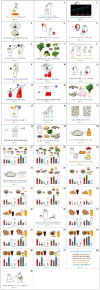Abstract
Objectives
The purpose of the study was to develop communication strategies for effective nutrition education targeting pregnant women and to create nutrition education contents.
Methods
The format and the contents of online resources on nutrition information for pregnant women provided by reliable institutions were analyzed. Possible solutions to overcome barriers of nutrition education as well as communication strategies for effective nutrition education were identified by a brainstorming process. Based on the communication strategies, contents for nutrition education were created. Understandability, level of interest, applicability to daily life, harmony of text and illustration, and overall satisfaction of the contents were evaluated by dietitians and pregnant women.
Results
The four communication strategies were developed; (1) to focus on a few important messages, (2) to provide evidence-based information, (3) to create illustrations or infographics with a minimum amount of text, and (4) to provide tips on how to improve the current diet options. Based on these strategies, the contents were focused on three important nutrients for pregnant women, folate, iron, and calcium. The percentages of the recommended nutrient intakes of the three nutrients on selected menu and its improved version by adding a dish or changing a dish into another dish were calculated and provided. Finally, the contents were delivered as illustrations with a minimum amount of text. Overall, dietitians and pregnant women were satisfied with the contents.
Figures and Tables
 | Fig. 1Pregnant women's barriers to implement nutrition education and possible solutions to overcome the barrier |
Table 2
Number of pages of the contents including text and illustration on energy and nutrients for pregnant women

References
1. Hanson MA, Bardsley A, De-Regil LM, Moore SE, Oken E, Poston L. The International Federation of Gynecology and Obstetrics (FIGO) recommendations on adolescent, preconception, and maternal nutrition: “Think Nutrition First”. Int J Gynaecol Obstet. 2015; 131(S4):S213–S253.
2. Statistics Korea. 2015 Annual Report of Live Births and Deaths Statistics (Based on vital registration) [Internet]. Statistics Korea;2016. cited 2017 Mar 3. Available from: http://kosis.kr/ups/ups_01List.jsp.
3. Lamichhane DK, Leem JH, Park M, Kim JA, Kim HC, Kim JH. Increased prevalence of some birth defects in Korea, 2009-2010. BMC Pregnancy Childbirth. 2016; 16(1):61.
4. Lee SL. Trend and policy issue of abnormal birth. Health Welfare Issue Focus 251 [Internet]. Korea Institute for Health and Social Affairs;2014. cited 2017 Mar 3. Available from: http://www.kihasa.re.kr/html/jsp/publicaion/periodical/focus/list.jsp.
5. Korea Health Industry Development Institute. Dietary intake survey of physiologically vulnerable population for risk assessment [Internet]. Korea Health Industry Development Institute;2014. cited 2017 Mar 15. Available from: https://www.khidi.or.kr/board/view?pageNum=2&rowCnt=10&no1=78&linkId=100750&menuId=MENU00085&maxIndex=00001786749998&minIndex=00001000799998&schType=1&schText=&boardStyle=&categoryId=09&continent=&country=.
6. Choi AR. Folate intake and food sources in the Korean population based on 2008-2009 Korea National Health and Nutrition Examination Survey [master's thesis]. Chungbuk National University;2012.
7. Kim JE, Park DY. A study on pregnant women's experience about nutrition education. Korean J Community Living Sci. 2012; 23(3):347–356.
8. Bookari K, Yeatman H, Williamson M. Falling short of dietary guidelines - What do Australian pregnant women really know? A cross sectional study. Women Birth. 2017; 30(1):9–17.
9. Lee SY. A study on third-trimester gravidas' knowledge of infant care activity. Korean Nurse. 1990; 29(3):64–77.
10. Kim SB, Kim JW, Kim MH, Cho YS, Kim SN, Lim HS. A study on consumer's needs for development of diet guide application for pregnant women. Korean J Community Nutr. 2013; 18(6):588–598.
11. Wang HJ, Park HS, Kim IO. Comparison of prenatal health management state and educational needs for pregnant women with advanced maternal age and under the age of 35. Korean J Women Health Nurs. 2013; 19(4):230–241.
12. Kim MJ. Nutritional status, eating habit, knowledge level and obstetric outcome in pregnant women with old age [master's thesis]. Hanyang University;2014.
13. Lee SL. A study on the management and support of maternal health before pregnancy for women of childbearing age [Internet]. Korea Institute for Health and Social Affairs;2013. cited 2017 Mar 3. Available from: https://www.kihasa.re.kr/web/publication/newbooks_pdsissue/view.do?menuId=43&tid=71&bid=18&ano=1665.
14. Peregrin T. Understanding millennial grocery shoppers' behavior and the role of the registered dietitian nutritionist. J Acad Nutr Diet. 2015; 115(9):1380–1381.
15. Chun KW. A literature review on the brainstorming. J Creativity Educ. 1997; 1(1):29–64.
16. National Institute of Agricultural Sciences. Food composition table. 8th revision. Suwon: National Institute of Agricultural Sciences;2011.
17. Ministry of Health and Welfare, The Korean Nutrition Society. Dietary reference intakes for Koreans 2015. Sejong: Ministry of Health and Welfare;2015.
18. Choi HJ. A study on use of eating out and nutrition labeling of pregnant women in Ulsan [master's thesis]. Ulsan University;2009.
19. Kim JH, Lee EJ, Hyun T. Dietary folate intake and food sources of children and adolescents in Chungcheong area: Using nutrient database revised by measured folate in selected foods. J Nutr Health. 2015; 48(1):94–104.
20. Hwang JY, Lee JY, Kim KN, Kim H, Ha EH, Park H. Maternal iron intake at mid-pregnancy is associated with reduced fetal growth: results from Mothers and Children's Environmental Health (MOCEH) study. Nutr J. 2013; 12(1):38.
21. Kim H, Kim KN, Hwang JY, Ha EH, Park H, Ha M. Relation between serum folate status and blood mercury concentrations in pregnant women. Nutr. 2013; 29(3):514–518.
22. Kim MR, Hyun TS. Satisfaction of Nutri-Plus program and improvement of nutritional status among the participants in Cheongju. J Hum Ecol. 2012; 16(1):105–114.
23. Kim T, Park S. A study on effects of elementary school students' use of smart phone upon reading and self-regulated reading. J Korean Assoc Inf Edu. 2014; 18(3):433–442.
24. Yoon KH, Jung KH, Choi IS, Choi HS. Features of Korean webtoons through the statistical analysis. Cartoon Animat Stud. 2015; 38:177–194.
25. Jung SY. Analysis of the current utilization situation and type of the card news of the big data era. J Korean Soc Des Cult. 2015; 21(4):609–620.




 PDF
PDF ePub
ePub Citation
Citation Print
Print







 XML Download
XML Download